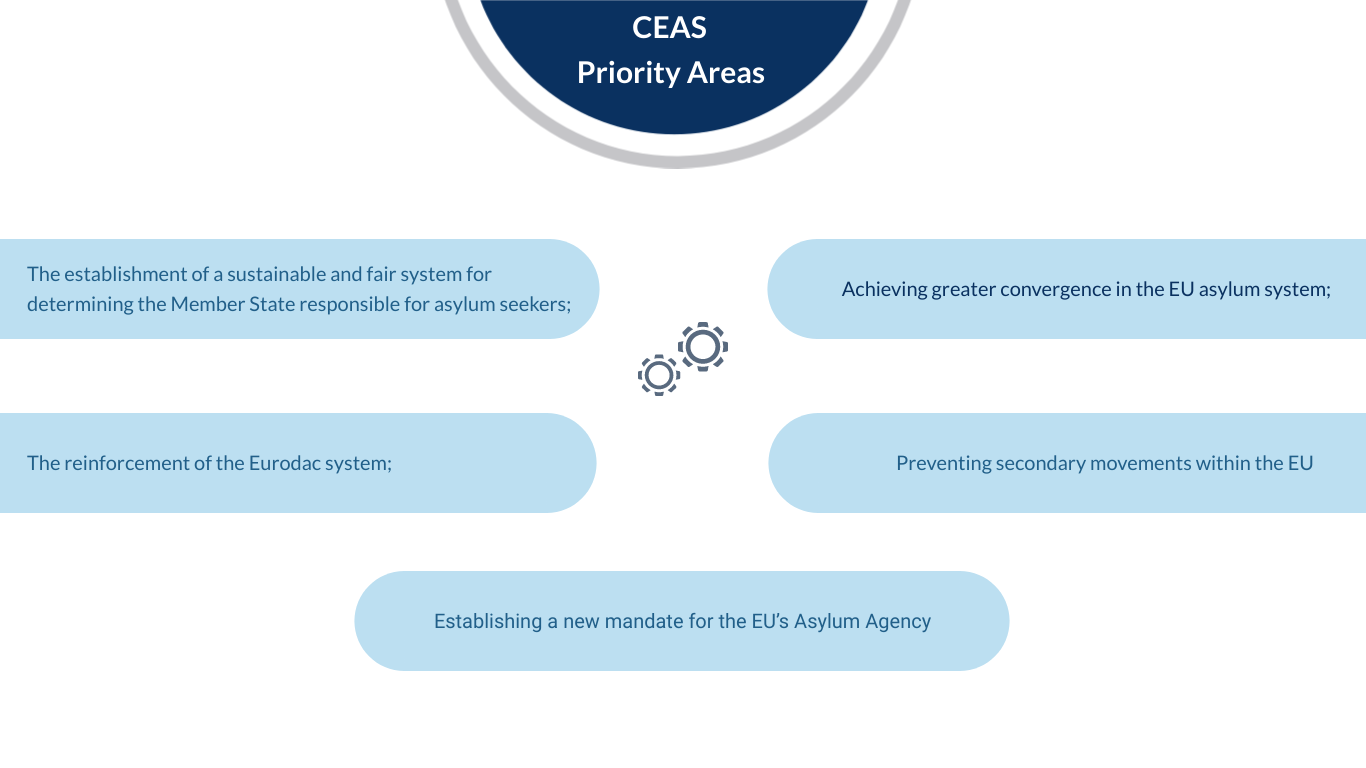The aim of the Common European Asylum System (CEAS) is to develop the architecture for a common approach in guaranteeing high standards of protection for refugees through fair and effective procedures throughout the EU+. It emphasises a common responsibility to welcome applicants for international protection in a dignified manner, ensuring fair treatment and examination of their applications according to uniform standards. 3 To this end, increased solidarity among countries and a sense of shared responsibility are foundation for the functioning and further calibration of the CEAS. As a result of the increased pressure that national asylum systems in EU+ faced over the past years, on 6 April 2016 the EU Commission, in its Communication Towards a reform of the Common European Asylum System and enhancing legal avenues to Europe, 4 identified five priority areas for the structural enhancement of the CEAS:

Subsequently, on 4 May 2016, the Commission presented a first package of reform proposals, including:
| A reform of the Dublin System to better allocate asylum applications among EU+ countries; 5 | |
| Steps toward reinforcing the Eurodac regulation, including to increase the efficiency of the EU fingerprint database for asylum seekers;6 and | |
| The strengthening of the mandate of the European Asylum Support Office toward a fully fledged agency for asylum.7 |
This was followed, on 13 July 2016, by a second package of proposals to reform the CEAS,8 which included:
| Replacing the Asylum Procedures Directive with a regulation, directly applicable in the national asylum systems, to harmonise asylum procedures across EU+ countries and achieve convergence in recognition rates; | |
| Replacing the Qualification Directive with a regulation, directly applicable in the national asylum systems to harmonise protection standards and rights for asylum seekers; and | |
| Reforming the Reception Conditions Directive to ensure that applicants for international protection benefit from harmonised and dignified reception standards and prevent secondary movements and abuse. |
Finally, as part of this ongoing round of proposals toward reforming the CEAS, the Commission put forth a proposal for the establishment of a permanent EU resettlement framework to replace existing ad hoc resettlement schemes. The Union Resettlement Framework Regulation will provide for legal and safe pathways to the EU, complementing ongoing resettlement and humanitarian admission initiatives in the EU framework and contributing to international resettlement initiatives. It will also assist in relieving pressure for countries hosting large numbers of people in need of international protection, while reducing the risk of irregular arrivals.
In 2018, the inter-institutional negotiations on the asylum reform proposals continued. In December 2017, the European Council had set a target to reach a position on an overall reform by June 2018.9 10 Sgnificant progress was made on five out of seven proposals and the Commission considers that they are ready to be finalised: the EU Asylum Agency, the Eurodac Regulation, the EU Resettlement Framework Regulation, the Qualification Regulation and the Reception Conditions Directive 11 Still, divergences on a number of controversial issues persisted and the majority of Member States expressed reservations in adopting one or more of the asylum reform proposals before all of them were ready for adoption, despite the benefit of adopting each individual proposal separately.12 Since, despite some progress at the technical level, the Council has not been able to adopt a position on the Dublin Regulation and the Asylum Procedure Regulation, the asylum reform has not yet been finalised. The European Parliament adopted its position on the Asylum Procedure Regulation in 2018 13 , and since it was the only pending position at this legislative procedural level, it has adopted positions on all the CEAS files.
State of play of the CEAS Reform process
In August 2018, the European Council on Refugees and Exiles (ECRE) published a policy paper taking stock of the hitherto progress of the negotiations on the CEAS reform, offering its analysis of the proposals launched at the June 2018 European Council, and presenting remaining questions and concerns. Among others, ECRE emphasises the importance of an agreement on the reform of the Dublin system as a key to achieving a breakthrough in the whole package. 14
Click to enlarge
______
3 European Commission, DG Home, Common European Asylum System.
4 European Commission, Towards a Reform of the Common European Asylum System and Enhancing Legal Avenues to Europe, COM/2016/0197 final.
5 European Commission, Proposal for a recast Dublin III Regulation, COM/2016/0270 final/2.
6 European Commission, Proposal for a Eurodac Regulation, COM/2016/0272 final.
7 European Commission, Proposal for an EUAA Regulation, COM/2016/0271 final.
8 European Commission, Completing the reform of the Common European Asylum System: towards an efficient, fair and humane asylum policy.
9 European Council, Remarks by President Donald Tusk following the European Council meetings on 14 and 15 December 2017.
10 European Council, Leaders Agenda. Migration: way forward on the external and internal dimension.
11 European Commission, Managing Migration in all its aspects: Commission Note ahead of the June European Council 2018.
12 European Commission, Managing Migration: Commission calls time on asylum reform stalling.
13 European Parliament, Report on the proposal for a regulation of the European Parliament and of the Council establishing a common procedure for international protection in the Union and repealing Directive 2013/32/EU.
14 ECRE, Asylum at the European Council 2018: Outsourcing or Reform?
15 European Council, Reform of EU asylum rules, Overview and Timeline.
